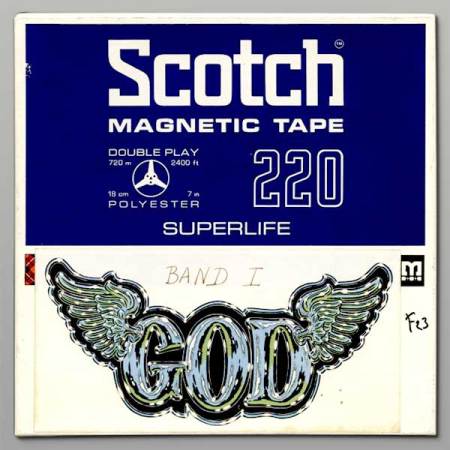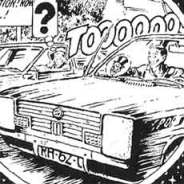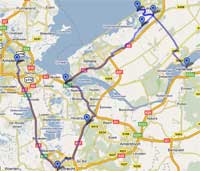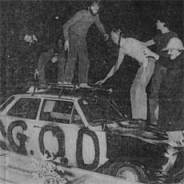

![The Time Machine [from WFMU] The Time Machine [from WFMU]](https://continuo.files.wordpress.com/2010/03/ephizmiz-time-machine.jpg?w=400&h=265)
In The KLF’s 1990 Chill Out, the car radio was a means for a psycho-geographic dérive in America’s Deep South through TV-evangelists’ rants, traffic-accident reports, Tuvan throat singing and sheep herds. In The Faust Cycle, completed January 2010, English sampler virtuoso Ergo Phizmiz (born 1980) embarks in a similar dérive, though he eventually gets rid of any excuse or plausible scenario to let his mind become a permanent radio dial switching between 78 rpm shellac records, music automata, string quartets and cuckoo clocks. In this surrealist aural freak show, Phizmiz attempts to capture the last signals from 20th century’s murmuring agony, from Morse code to music boxes, from 78s to ukulele, from silent movies to bird recordings. This mammoth mix collects sonic memes and blends them with Phizmiz’s own obsessions: music machines, bird songs, Gramophones, scatology, artists as divine figures. Exploring the dark recesses of the Doctor’s House, he encounters the many faces of Faustus: the Artists, the Creators, the Originals, the Freaks, the Musicians, etc, and eventually finds a family among them. But Phizmiz is not alone in this adventure and Faust includes a host of collaborators, sponsors and music workshop participants. The former contribute a series of fantastic pop songs and incidental music, while the latter add awkwardness and freshness to the music – all enhance The Faust Cycle‘s collective experience. For Phizmiz has the ability to let other people’s creativity blossom, embedded inside his own work, and most composers will look narrow-minded, even unidimensional, compared to Phizmiz.
For instance, Chunk #3 incorporates rehearsals and final interpretation by amateur young people from the Isle of Wight (around 1h44). In the course of their workshop with Ergo Phizmiz, they created an alternative soundtrack to Murnau’s 1926 Faustus film, based on ukulele, melodica, piano, xylophones, marimbas, assorted percussion and. . . Drinking Lucky Bird [+]. The ensemble reminds some of Cornelius Cardew’s Scratch Orchestra experimentations. This episode #3 is typical of all the Cycle. It has collage and electroacoustic music by Angela Valid, on top of which Phizmiz has plenty of time to retell an episode from Homer’s Illiad. A ventriloquist duo eventually disrupts any common sense left. In an hilarious scatological passage around 2h10mn, the mix transforms into a radio drama where the narrator gets way of his soul in the toilet bowl, or porcelain. The passage eventually leads to Doctor Faustus’ sewer system. Episode ends with a desolate violin solo by Amie Willingale, followed by a no less sad, Liszt-ian piano solo, presumably an interpretation of Erik Satie’s Le Tango Perpétuel by James Nye.
The sublime first half of Chunk #4 is devoted to Bird Machines. After we’ve heard Duchamp lecturing birds, after a brief encounter with a Gramophone walking on 4 legs playing dusty shellac discs, the mix describes a series of bird machines, including a Night Jar-Machine, a Duck-Machine, a Cuckoo-Machine, all inspired by an obsession with Vaucanson’s mechanical duck. The rest of Chunk #4 has birds and nature recordings, sped-up frog recordings, Tibetan bells (56:00), slowed down bird songs mixed with 78s sizzling sounds, close to some of Philip Jeck’s own work. Also included is a great song about a Cassowary (49:15) that praises “the amazing benefits of grazing”, and an homage to Joseph Cornell – to which the Cycle is dedicated. Elsewhere, Cornell is described as ‘an assistant of Faustus’ (Chunk #2, 26:00). Martha Moopette also contributes extensively to the project in various Chunks, and it all ends with a sublime field recording of a brook and birds by The Travelling Moongoose (Chunk #5, 2h40mn).
*
* *
Below: some of the visual inspiration for The Faust Cycle.
Can you spot Faustus among them?
* *
*
Subtitled ‘An adventure for radio’, The Faust Cycle is after all a regular radio play, where Phizmiz narrates his own adventures, leading us from place to place, from implausible stairs to the next imaginary room. Episodes of the Cycle have been aired on various radios between 2008 and 2010, including WFMU. The Faust Cycle would not have been possible without mp3 technology and the ability to store thousands of sound files on a hard drive and the whole project is quite vertiginous when you think about it: it contains samples of music (78rpm and other records), but also samples from sample-based music (guest contributors). In any case, The Faust Cycle is the most ambitious music project conceived in the 21st century and certainly the only one able to challenge your listening habits. That it is available for free and doesn’t fit on a regular disc speaks volumes as to the state of music today.
Download from Headphonica. Visit Ergo Phizmiz’s blog.




![Katalin Ladik & Gábor Fülöp [2 radio plays] LP front cover Katalin Ladik & Gábor Fülöp [2 radio plays] LP front cover](https://continuo.files.wordpress.com/2011/09/ladikgabor-lp-front.jpg?w=350&h=349)
![Katalin Ladik & Gábor Fülöp [2 radio plays] LP back cover Katalin Ladik & Gábor Fülöp [2 radio plays] LP back cover](https://continuo.files.wordpress.com/2011/09/ladikgabor-lp-back.jpg?w=350&h=349)
![Katalin Ladik & Gábor Fülöp [2 radio plays] LP side 1 Katalin Ladik & Gábor Fülöp [2 radio plays] LP side 1](https://continuo.files.wordpress.com/2011/09/ladikgabor-lp-side1.jpg?w=350&h=233)






![The Time Machine [from WFMU] The Time Machine [from WFMU]](https://continuo.files.wordpress.com/2010/03/ephizmiz-time-machine.jpg?w=400&h=265)




























